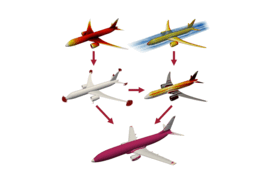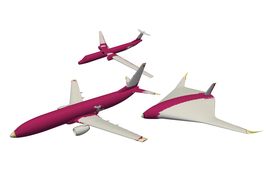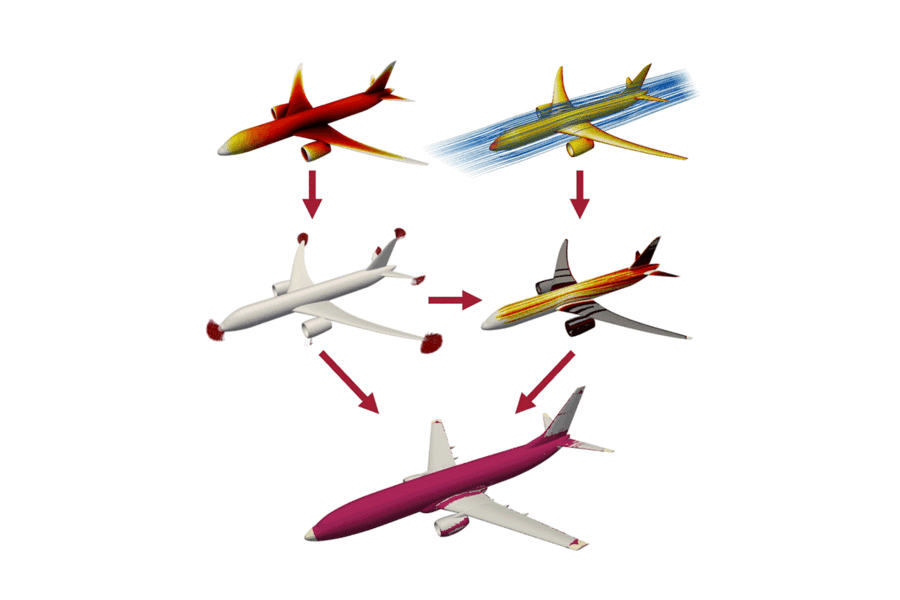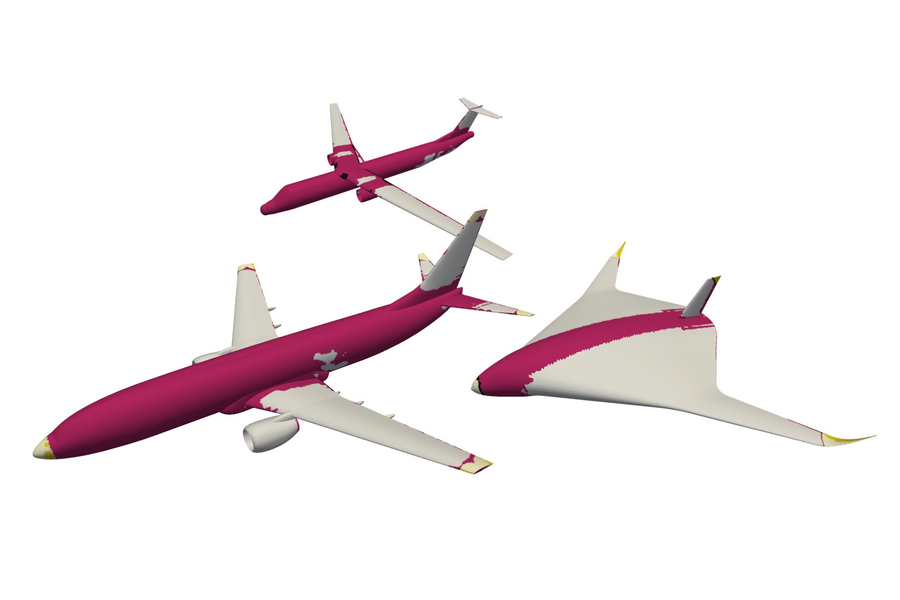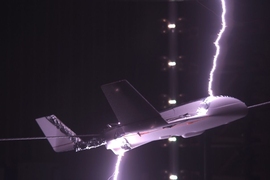Audio
More than 70 aircraft are struck by lightning every day. If you happen to be flying when a strike occurs, chances are you won’t feel a thing, thanks to lightning protection measures that are embedded in key zones throughout the aircraft.
Lightning protection systems work well, largely because they are designed for planes with a “tube-and-wing” structure, a simple geometry common to most aircraft today. But future airplanes may not look and fly the same way. The aviation industry is exploring new designs, including blended-wing bodies and truss-braced wings, partly to reduce fuel and weight costs. But researchers don’t yet know how these unconventional designs might respond to lightning strikes.
MIT aerospace engineers are hoping to change that with a new physics-based approach that predicts how lightning would sweep across a plane with any design. The tool then generates a zoning map highlighting sections of an aircraft that would require various degrees of lightning protection, given how they are likely to experience a strike.
“People are starting to conceive aircraft that look very different from what we’re used to, and we can’t apply exactly what we know from historical data to these new configurations because they’re just too different,” says Carmen Guerra-Garcia, associate professor of aeronautics and astronautics (AeroAstro) at MIT. “Physics-based methods are universal. They’re agnostic to the type of geometry or vehicle. This is the path forward to be able to do this lightning zoning and protect future aircraft.”
She and her colleagues report their results in a study appearing this week in IEEE Access. The study’s first author is AeroAstro graduate student Nathanael Jenkins. Other co-authors include Louisa Michael and Benjamin Westin of Boeing Research and Technology.
First strike
When lightning strikes, it first attaches to a part of a plane — typically a sharp edge or extremity — and hangs on for up to a second. During this brief flash, the plane continues speeding through the air, causing the lightning current to “sweep” over parts of its surface, potentially changing in intensity and re-attaching at certain points where the intense current flow could damage vulnerable sections of an aircraft.
In previous work, Guerra-Garcia’s group developed a model to predict the parts of a plane where lightning is most likely to first connect. That work, led by graduate student Sam Austin, established a starting point for the team’s new work, which aims to predict how and where the lightning will then sweep over the plane’s surface. The team next converted their lightning sweep predictions into zoning maps to identify vulnerable regions requiring certain levels of protection.
A typical tube-and-wing plane is divided into three main zones, as classified by the aviation industry. Each zone has a clear description of the level of current it must withstand in order to be certified for flight. Parts of a plane that are more likely to be hit by lightning are generally classified as zone 1 and require more protection, which can include embedded metal foil in the skin of the airplane that conducts away a lightning current.
To date, an airplane’s lightning zones have been determined over many years of flight inspections after lightning strikes and fine-tuning of protection measures. Guerra-Garcia and her colleagues looked to develop a zoning approach based on physics, rather than historical flight data. Such a physics-based mapping could be applied to any shape of aircraft, such as unconventional and largely untested designs, to identify regions that really require reinforcement.
“Protecting aircraft from lightning is heavy,” Jenkins says. “Embedding copper mesh or foil throughout an aircraft is an added weight penalty. And if we had the greatest level of protection for every part of the plane’s surface, the plane would weigh far too much. So zoning is about trying to optimize the weight of the system while also having it be as safe as possible.”
In the zone
For their new approach, the team developed a model to predict the pattern of lightning sweep and the corresponding lightning protection zones, for a given airplane geometry. Starting with a specific airplane shape — in their case, a typical tube-and-wing structure — the researchers simulated the fluid dynamics, or how air would flow around a plane, given a certain speed, altitude, and pitch angle. They also incorporated their previous model that predicts the places where lightning is more likely to initially attach.
For each initial attachment point, the team simulated tens of thousands of potential lightning arcs, or angles from which the current strikes the plane. They then ran the model forward to predict how the tens of thousands of potential strikes would follow the air flow across the plane’s surface. These runs produced a statistical representation of where lightning, striking a specific point on a plane, is likely to flow and potentially cause damage. The team converted this statistical representation into a map of zones of varying vulnerability.
They validated the method on a conventional tube-and-wing structure, showing that the zoning maps generated by the physics-based approach were consistent with what the aviation industry has determined over decades of fine-tuning.
“We now have a physics-based tool that provides some metrics like the probability of lightning attachment and dwell time, which is how long an arc will linger at a specific point,” Guerra-Garcia explains. “We convert those physics metrics into zoning maps to show, if I’m in this red region, the lightning arc will stay for a long time, so that region needs to be heavily protected.”
The team is starting to apply the approach to new geometries, such as blended-wing designs and truss-braced structures. The researchers envision that the tool can help designers incorporate safe and efficient lightning-protection systems early on in the design process.
“Lightning is incredible and terrifying at the same time, and I have full confidence in flying on planes at the moment,” Jenkins says. “I want to have that same confidence in 20 years’ time. So, we need a new way to zone aircraft.”
“With physics-based methods like the ones developed with professor Guerra-Garcia’s group we have the opportunity to shape industry standards and as an industry rely on the underlying physics to develop guidelines for aircraft certification through simulation,” says co-author Louisa Michael of Boeing Technology Innovation. Currently, we are engaging with industrial committees to propose these methods to be included in Aerospace Recommended Practices.”
“Zoning unconventional aircraft is not an easy task,” adds co-author Ben Westin of Boeing Technology Innovation. “But these methods will allow us to confidently identify which threat levels each part of the aircraft needs to be protected against and certified for, and they give our design engineers a platform to do their best work to optimize aircraft design.”
Beyond airplanes, Guerra-Garcia is looking at ways to adapt the lightning protection model to other technologies, including wind turbines.
“About 60 percent of blade losses are due to lightning and will become worse as we move offshore because wind turbines will be even bigger and more susceptible to upward lightning,” she says. “They have many of the same challenges of a flowing gas environment. It’s more complex, and we will apply this same sort of methodology to this space.”
This research was funded, in part, by the Boeing Company.
